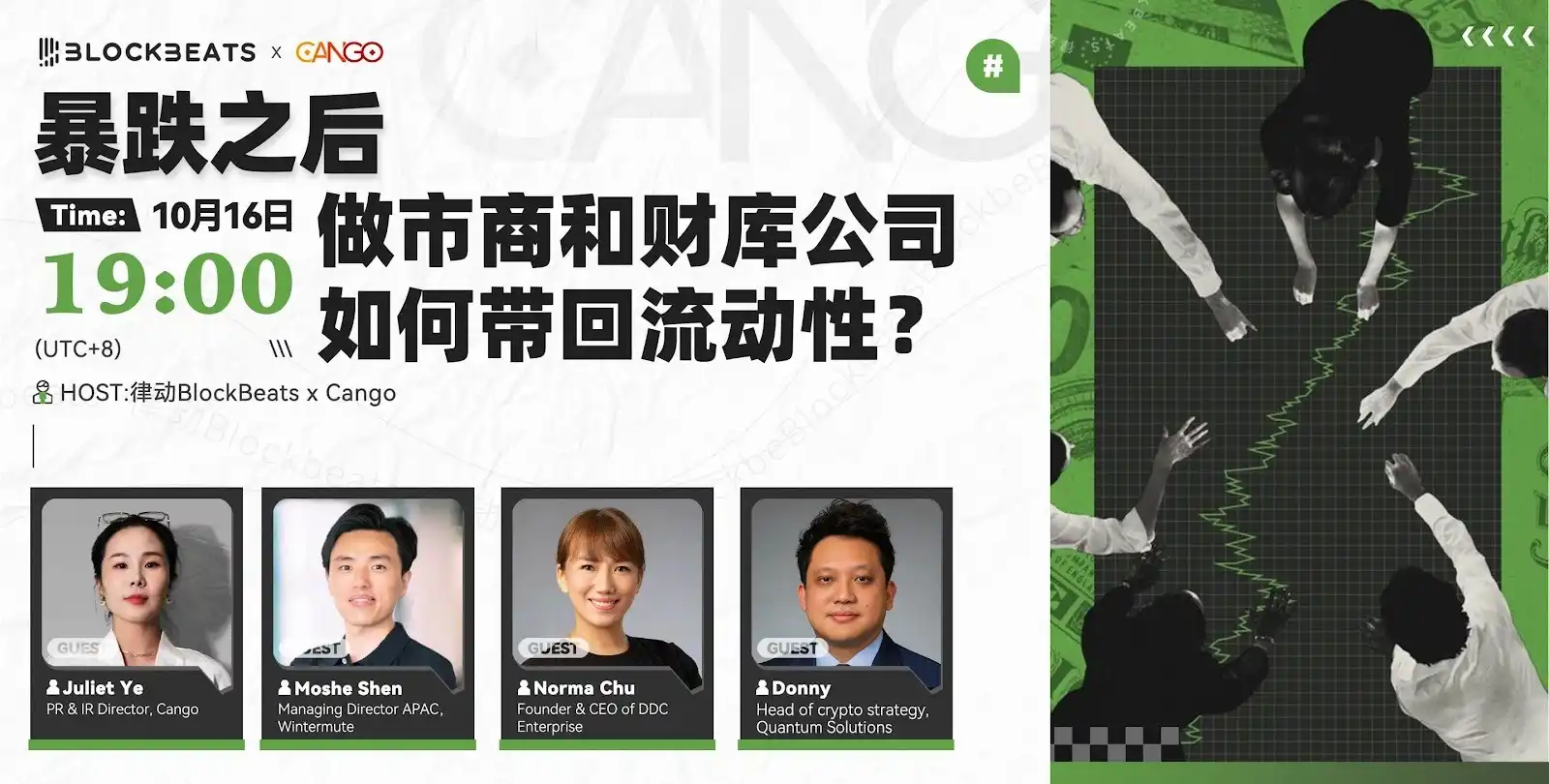X Space Review | After the Crash, How Did Liquidity Providers and Treasury Firms Bring Back Liquidity?
CanGu, as the world's second-largest Bitcoin mining company, has adopted an "All in" strategy to balance short-term pains and long-term gains through opportunistic market entry, a light asset model, and geographic decentralization. Its single-coin cash cost for Bitcoin mining is about $83,000, with an all-in sustaining cost of around $98,000.
After experiencing the "1011" crash, is your asset still okay? When will liquidity truly return? On the night of October 16th, BlockBeats invited four guests: Juliet Ye, Head of IR at Cango, a Bitcoin mining company listed on the NYSE; Moshe Shen, Asia Pacific Managing Director at Wintermute, a crypto-native algorithmic liquidity provider; Norma Chu, Founder of DDC, a Bitcoin treasury company; and Donny, Cryptocurrency Strategy Lead at Quantum Solutions. The theme was "After the Crash, How Do Market Makers and Treasury Companies Restore Liquidity?" Together, they discussed their feelings and responses during the crash. As foundational forces in the market, how will they act post this crisis to reinvigorate a sluggish market?

BlockBeats: Hello everyone, welcome to our AMA today. Recently, due to the impact of Trump's latest tariff policy, the crypto industry has seen significant price fluctuations, leading to the largest liquidation amount in history. Additionally, this year is crucial for crypto compliance, with many institutions bringing new liquidity to the industry through treasury companies. Today, we have invited treasury companies and market makers to discuss the future market trends and industry outlook.
First, please introduce yourselves, and briefly share your views on the future development of Treasury companies following the DAT model.
Juliet Ye: Hello, I'm Juliet from Cango, a Bitcoin mining company listed on the NYSE, responsible for investor relations and public relations. I'm delighted to participate in today's online event.
Moshe Shen: I'm Moshe Shen, Asia Pacific Managing Director at Wintermute, primarily responsible for expanding OTC crypto trading and partnerships in Asia. Before joining the crypto industry, I worked at Goldman Sachs for over ten years, engaging in stock trading, sales, and prime brokerage in London and Hong Kong. Wintermute is one of the world's leading crypto-native algorithmic liquidity providers. We offer liquidity algorithmically on most cryptocurrency exchanges and platforms, provide diverse OTC trading products, and support top Web3 projects and traditional financial institutions entering the crypto space.
We also actively participate in the crypto ecosystem through investments, partnerships, and project incubation. Founded in 2017, the company has successfully navigated multiple crypto market cycles. Our culture integrates the technical standards of traditional high-frequency trading (HFT) firms with the innovation and entrepreneurial spirit of tech startups.
Norma: Hello everyone, I am Norma Chu, the founder, chairman, and CEO of DDC Group. My entrepreneurial journey began in the food industry—starting from a cooking sharing platform, I have developed DDC into a globally listed Asian food company on the New York Stock Exchange. Today, we are also one of the fastest-growing Bitcoin treasury companies globally.
Since officially launching our Bitcoin strategy in May of this year, we have accumulated over 1,000 Bitcoins within 100 days, placing us among the top 50 publicly listed Bitcoin-holding institutions globally. Before founding DDC, I served as the Stock Research Head at HSBC's Private Wealth Management division. Although my background is in finance, I have always believed that true innovation often arises at seemingly unrelated intersections— for us, it is the fusion of food, finance, and technology. This is also the driving force behind me and my team's daily progress.
Donny: Hello everyone, I am Donny, the Cryptocurrency Strategy Lead at Quantum Solutions. I have known the QS management for over two years. Due to the new CEO's expertise in international capital markets, I participated in the investment when he took office and immediately joined the team to oversee cryptocurrency strategy and fundraising.
BlockBeats: The concept of DAT in the market is no longer unfamiliar, and now some viewpoints believe that DAT companies are not sustainable. Some short-selling institutions have started shorting DAT stocks. How do the guests view the future development of this DAT model?
Juliet Ye: In fact, the core challenge for DAT companies is how to make the traditional capital market understand the value fluctuation of on-chain assets. We see that DAT companies with a single business model may indeed be more affected by market cycles. However, those listed companies with transparent holdings and a well-structured compliance framework can still gain the long-term trust of capital. The key is for companies to establish a dual valuation model—looking not only at traditional cash flow but also at on-chain asset value, and bridging the market's understanding gap through continuous and comprehensive disclosure. From the current position of Canaan in the Bitcoin mining industry, we may see a trend of business divestitures in the future, such as separating Bitcoin mining and AI computing power services into independently operated entities, which can better unlock their respective values.
Norma: I actually don't think the market has fully understood the concept of a "Bitcoin Treasury Company" yet. There are still three major misconceptions about these companies in the market.
First, many people think that the Bitcoin Treasury Company strategy is just a short-term trend, as if it is a group of companies taking advantage of the hype to raise funds to buy Bitcoin, and once the market hype is over, these companies will also disappear. But I believe we have moved beyond this "experimentation phase." From early pioneers like MicroStrategy, we have already seen that a Bitcoin treasury strategy's structure, management style, and financing model can impact shareholder value.
Second, the differences in strategy execution among different treasury companies are actually very significant, with each company having its own ideas and development paths. However, because this industry is still very new, the market currently lacks the ability to differentiate these nuances. Investors now tend to only look at a single metric to evaluate a company, just like in traditional finance, if you only look at the P/E ratio to decide on buying or selling stocks, that is obviously not comprehensive enough.
Third, there is a misconception that treasury companies are just "high-leverage Bitcoin ETFs," and some even say, "Why don't I just buy an ETF directly?" However, looking at the issue this way is too superficial. For example, a individual investor in a bank (such as HSBC) can only access services like credit cards, loans, mortgages, etc., but if you are a $500 million market cap company, the services and products a bank can provide are completely different. Similarly, companies like DDC, as enterprise treasuries, can access many financial products that ordinary individual investors or ETFs cannot, such as structured derivatives and risk hedging tools. We can more flexibly manage assets, and shareholders entrust us to manage their indirect Bitcoin holdings, believing that our professional capabilities can create higher long-term returns.
Next, I believe there will be three important trends in the future of the Bitcoin Treasury model:
First, this is still only the first year of the Bitcoin Treasury, with roughly only about 200 public companies worldwide holding Bitcoin, accounting for less than 0.5% of the total number of public companies globally. This number is actually very small. In the future, more and more companies will incorporate Bitcoin into their asset allocation. They may not all be pure data companies, but there is still a lot of room for enterprises to use Bitcoin as a treasury asset.
Second, not all treasury companies are the same. We are currently in the "first stage," where the market's focus is mainly on "who is financing, who is buying." As we move to a more mature stage, differences will become more apparent: which companies can continue to execute, which companies can operate maturely in the capital markets, and which can clearly explain their strategies to the market. Different companies will use different methods to enhance the value created for shareholders by their Bitcoin assets. We have already seen some treasury companies start to invest in each other, and even merge, which is the evolution of this industry.
Third, I believe the market should not isolate treasury companies. Their development is actually influenced by some larger structural trends. For example, artificial intelligence. Hardly anyone discusses the application of AI in treasury asset management, but it could become a significant turning point in the future. Companies that can develop AI-driven asset management tools first are likely to stand out in this field.
There is also a growing trend in the comprehensive tokenization of assets. How future treasury companies leverage this new form of assets to enhance returns will be a key proposition.
Lastly, as more companies hold Bitcoin, the entire ecosystem of products will become richer—including various innovative yield products. This is very positive for the long-term development of the industry.
Moshe: This question mainly needs a response from DAT Company itself. From our perspective, long-term success depends on differentiation and execution. DAT companies that focus on sustainable business models, corporate development (M&A/expansion), and proactive treasury management, utilizing various tools to create value and returns for shareholders, will be in a more advantageous position for future growth.
Donny: Once a metric is used to price a stock, it's hard to return to the "pure hype" before the introduction of that metric. For DAT, the headache-inducing metric is mNAV. The key is to break free from the constraints of mNAV: to truly leverage the treasury, ideally working in synergy with the company's existing business.
Digital asset treasury should be a part of the business, rather than a category label attached to the company. The treasury must be "active," adding value to the market, bringing returns to shareholders, and creating a situation where the company's value is no longer solely tied to the underlying asset price of the treasury.
BlockBeats: Let's first ask Canaan, as the world's second-largest Bitcoin mining company, when it initially sold its traditional business for $350 million and fully invested in the crypto field, what was the risk assessment logic behind this All-in strategy?
Juliet Ye: Our decision to fully transition in 2024 was not a sudden move or following a trend, but a result of thorough analysis and demonstration: First, the timing—the choice of timing. We started to explore and understand the industry from the end of '23 and deeply explored the feasibility of a thorough industry transition starting around mid-'24. It can be said that at that time, the coin was at a cyclical low, the mining power competition was not as intense as it is now, and mining machine prices were relatively cheap. Canaan laid the foundation for low-cost expansion by acquiring 50 EH/s of mining power scale through equity swaps and cash combination.
Secondly, financial security—before the transition, Canaan was already a net cash company with $500 million in liquidity, providing us with the financial possibility to seek transformation. In addition, the cash flow of $350 million brought about by the divestiture of the traditional business during the transformation process, as of the end of the second quarter, our cash and cash equivalents exceeded $100 million, and there are over 6,000 Bitcoins in reserve currently in our accounts. All of these have paved the way for Canaan's transformation and deep industry cultivation.
Lastly, there is the dynamic adjustment capability—such as being able to hedge against price volatility by flexibly adjusting the mining machine's operating rate; our mining machines are widely distributed in countries and regions including the United States, East Africa, Oman, and Paraguay, leveraging regional differences in electricity prices and policy stability to mitigate regulatory and operational risks.
Overall, Canaan's "All in" strategy is centered around opportunistic market entry, a light-asset model, and geographic diversification as core risk management pillars, aiming to strike a balance between short-term pains and long-term gains through proactively divesting inefficient assets and strengthening financial reserves.
BlockBeats: Compared to MicroStrategy's pure holding strategy, Canaan's unique "Mining + Holding" dual-driven model is distinctive. Approximately what is Canaan's cost of acquiring Bitcoin through mining? In the current highly competitive DATCO track, can this cost advantage build a strong enough moat?
Juliet Ye: As of the end of the second quarter, the company's single-coin cash cost for Bitcoin mining is approximately $83,000, plus around $15,000 in depreciation, resulting in a comprehensive single-coin cost of around $98,000. Due to the light-asset model the company has adopted—such as not self-building mining farms, using cost-effective second-hand machines, and opting for hosting instead of self-operated on-site teams—our single-coin cash cost is slightly higher compared to industry peers, but our comprehensive cost remains low within the industry, making us competitive.
Compared to companies that simply hold Bitcoin, Canaan is a production enterprise. We aim to continuously build a cost moat through three dimensions:
1) First, our current Bitcoin mining cost is below market price, and this cost advantage is operationally validated with actual data. For us, it is more cost-effective than directly buying coins in the market.
2) Second, we amplify earnings elasticity through dual leverage. On one hand, by rapidly achieving an industry-leading scale of computing power through a cash + equity combination, we essentially add computing power leverage. On the other hand, in day-to-day operations, we use Bitcoin collateralized financing to enhance capital turnover efficiency, adding operational leverage. The multiplier effect of this double leverage is higher than simply buying coins or investing in Bitcoin ETFs, allowing us to maximize gains from Bitcoin price appreciation.
3) Third, we implement strict equity dilution risk control. We raise funds through Bitcoin pledge loans, mining machine lease financing, and other tools to cover company operating expenses. This avoids frequent stock issuance, thus better protecting shareholder equity.
BlockBeats: Next, I'd like to ask about DDC. DDC Enterprise, as a NYSE-listed food company, why did it choose to make Bitcoin a significant part of its treasury assets?
Norma: I believe the reason we chose Bitcoin as our primary treasury asset stems from a forward-looking vision—a bridging of the gap between tradition and innovation. Fundamentally, we believe that today's treasury management is no longer just about value preservation or liquidity management but is a key part of strategic capital allocation.
In the traditional sense, most food companies hold traditional financial instruments such as cash or government bonds as treasury assets because it is the safest and most understood practice. However, we chose not to adhere to this traditional thinking because we see a structural shift happening in the capital markets and store of value. Bitcoin's essence is not just a digital asset but a new form of currency that aligns closely with the strategic direction of a rapidly growing, forward-thinking company like DDC.
Firstly, Bitcoin represents a redefinition of incentive mechanisms and sovereignty. Just as we strive to build value and trust in the food industry, Bitcoin's decentralized nature brings transparency, resilience, and resistance to control. Including Bitcoin on the balance sheet means we actively participate in a financial system that evolves in sync with the global digitization process, a systemic derisking that cash and bonds cannot achieve.
Secondly, for us, the treasury is not just about short-term liquidity or risk mitigation but is more about long-term capital appreciation and innovation. The food industry is inherently global and will continue to evolve with technology and changing consumer patterns. Bitcoin's open protocol and network effects reflect the transformation of consumer behavior and digital payment methods, aligning closely with the digitalization and internationalization direction of our business. Holding Bitcoin is our way of "preparing for the future" in an inflationary and currency devaluation environment.
Lastly, holding Bitcoin as a treasury asset allows us to convey a strong message to shareholders, employees, partners, and customers: DDC is not just safeguarding value but actively embracing change. This posture reflects our corporate culture, helping us attract a new generation of talent and partners, especially those who resonate with the open, transparent, and forward-thinking spirit of Generation Z consumers.
In short, DDC's choice of Bitcoin is not just about changing the structure of treasury assets but about driving the company and its investor ecosystem towards a digital and globalized future. This is our path at the intersection of food, finance, and technology, redefining capital strategy, achieving long-term growth, and countercyclical capabilities.
BlockBeats: Next, I'd like to discuss DAT from the perspective of a market maker. Firstly, the most pressing question everyone wants to know is regarding the recent sharp decline. Some believe it was caused by issues with market makers, and Wintermute has clarified that they had no issues. Do you know if any market makers experienced losses during this sharp decline?
Moshe Shen: Our observations in this round of volatility:
· Causes of mass liquidation: The result of multiple factors stacking up—significant news related to Trump coincided with the market leveraged long on multiple chains and on various on-chain/off-chain platforms. Price decline triggered the forced liquidation of leveraged positions hedged directionally and with Delta by exchanges' ADL (Automatic Deleveraging), further driving the price down, leading to a cascading chain reaction of liquidations.
· Wintermute's positions and practices: As a liquidity provider, we maintain very low leverage and very low directional exposure. A significant part of our business is OTC trading—we collaborate with nearly 3000 counterparties, including miners, DAT companies, project teams, and various types of investors. Our model focuses on earning spreads through hedged trades and cross-market arbitrage. This time, due to the significant price dislocation caused by liquidations, and with many exchanges experiencing extremely congested withdrawal queues, it has increased the difficulty of quickly rebalancing our positions and providing optimal liquidity across different exchanges.
· Broader market implications: We only discuss our own operations and do not comment on others. However, from public discussions, it is clear that such events are particularly challenging for institutions engaging in directional/leverage long and short trading—especially when passive ADL liquidates short legs, while long positions continue to incur losses as the price drops, amplifying risk exposure.
Throughout the entire weekend, we have maintained operational continuity, ready to provide quotes to counterparties at any time. We continue to offer liquidity whenever counterparties need it. Wintermute has remained operationally continuous.
BlockBeats: We also understand that Wintermute is currently providing market-making services for DAT Treasury. So, when providing market-making services for DAT Treasury, how does Wintermute ensure smoother and lower-cost Bitcoin liquidity for retail traders on exchanges?
Moshe Shen: Let's first clarify our role in the DAT space (different from traditional market-making):
How we support DAT Treasury: We do not provide liquidity for DAT stock itself. We mainly support in two treasury management aspects:
1. Digital asset accumulation: DAT can purchase spot directly through our OTC, avoiding exchange fees and reducing market impact;
2. Yield generation: Provide various yield strategies for DAT's holdings:
· Covered Put Selling: Generating premium income while executing an accumulation strategy;
· Digital Asset Loan Program;
· Principal-Protected Structured Product: Allowing idle USD/BTC to earn yield.
Since 2017, Wintermute has been a reliable liquidity provider. Currently, we provide approximately $15 billion in liquidity daily across centralized/decentralized exchanges, spot, perpetual, options, and other markets.
BlockBeats: I'd like to ask QS, how is QS currently participating in this DAT wave?
Donny: Quantum brought Ethereum DAT to Japan—becoming the first Japanese company to designate ETH as a 'core reserve' and publicly announce increased holdings. The Japanese stock market has hit a new high this year not seen since 1989: on one hand, policies encourage market entry, on the other hand, Japan acts more as a neutral hub in the US-China rivalry; coupled with platforms like IBKR, Futu making it easier for retail investors to buy Tokyo stocks. Japanese regulations are stricter, raising the threshold for digital asset strategy, but progress is more stable. It's worth mentioning that Quantum is the only Japanese crypto-related stock that has received global institutional 'anchored funds,' with no discount on financing, aligning incentives further.
Similar to BMNR, Quantum also emphasizes rapid accumulation and efficient fundraising, all within the regulatory framework.
We will also support institutional tools and platforms. The shared goal of ETH-type DAT is to drive greater institutional adoption of blockchain; this cannot be achieved without licensed DeFi/CeDeFi infrastructure—this may sound inconsistent with the instinct of a purely on-chain audience, but it does address key issues such as compliance, security, insurance for institutions. As large digital asset holders, their interests align with the industry as a whole, willing to push the industry forward together.
BlockBeats: Mining operations require ongoing capital investment, and Bitcoin prices are highly volatile. How does Canaan balance the contradiction between cash flow management and a long-term holding strategy?
Juliet Ye: This is a great question, with continuous large capital investment on one side and holding without selling on the other, finding the right balance is crucial. Our strategy involves leveraging and maintaining flexibility.
Bitcoin Mining, in fact, a significant portion of the operational cost comes from electricity bills. Here we use an electricity bill loan to alleviate cash flow pressure. This means we do not need to pay the full electricity bill immediately, only need to pay the loan interest monthly. This approach reduces short-term cash outflow pressure. By using Bitcoin as collateral to obtain a loan, as the long-term value of Bitcoin is recognized, there is no need for additional collateral, allowing for maximum leverage. In this mode, our cash reserves will be primarily used for expanding hash power or exploring new business opportunities. At the same time, by prioritizing operating expenses coverage through Bitcoin collateralized financing instead of selling Bitcoin directly, we can retain the long-term appreciation potential of Bitcoin and avoid equity dilution. Our debt-to-equity ratio remains low while leaving room for leverage.
Of course, our hodling strategy is not mechanically "never sell," but is based on a dynamic observation and adjustment mechanism with a triple trigger system. We consider multiple factors such as price, liquidity demand, and external risks to dynamically adjust our strategy. Naturally, we entered at the low point of the 2024 Bitcoin halving cycle to rapidly expand hash power at a low cost, aiming to maximize Bitcoin accumulation as a reserve asset for the next bull market. So, in principle, we will not easily change our hodling policy but will maximize long-term hodling returns while ensuring the security of cash flow, forming a sustainable balance mechanism.
BlockBeats: Many thanks to the guests from Cango, DDC, Wintermute, and QS for sharing insightful analysis and viewpoints. After this round of plunge, the risk has not been cleared, and fear and uncertainty persist. However, within fear, there is also pricing dislocation, and order can be restored in the wilderness. Thanks to the guests for sharing from a frontline perspective—from treasury assets, from rebuilding market depth, to compliance frameworks. The AMA ends here today, and we'll see you next time.
Disclaimer: The content of this article solely reflects the author's opinion and does not represent the platform in any capacity. This article is not intended to serve as a reference for making investment decisions.
You may also like
Trump Nominates Michael Selig to Lead CFTC Amid Crypto Oversight Push

XRP Price Holds at $2.58 as Traders Monitor Critical $2.60 Resistance Zone

Top Gainers in Crypto Today: Virtual Protocol Leads with 31.98% Increase

Dogecoin Approaches Critical Trendline Test at $0.1977 Amid Tight Market Range

